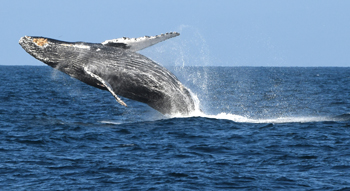Hoping to carve out a role for nanotechnology in treating life-threatening diseases, the University of California, Santa Barbara, and a medical research institute in San Diego County have formed a multimillion-dollar partnership to recruit up to 150 scientists and support staff and house a research center at UCSB.
Called the “Center for Nanomedicine,” the UCSB-Burnham Institute for Medical Research effort will start by pairing three nanotechnology researchers and three biologists to work on drug discovery, delivery systems and new imaging technology. Funding will come from a variety of research grants as well as private donations.
The partnership will eventually recruit a dozen faculty scientists, half to the faculty of UCSB and half to the Burnham Institute, and make its home on a whole floor of a research building at UCSB due for completion in 2016. Overall, the effort would create as many as 150 jobs for scientists and support staff.
No precise dollar figure has surfaced for the center. But working together over the past five years, Burnham and UCSB researchers have won more than $20 million in grants, and on Oct. 6, former Burnham president and current UCSB researcher Errki Ruoslahti won a $2.8 million award from the Department of Defense to research breast cancer detection and therapies using nanotechnology. 
The two organizations announced jointly on Sept. 30 they had hired Jamey D. Marth as director of the center. Marth, who received his doctoral degree at the University of Washington, was the first graduate student to work with Roger Perlmutter, now a Montecito resident and head of research at biotechnology giant Amgen, based in Thousand Oaks.
“A couple of years ago, we began to realize that a number of diseases escaped our understanding because they could not be solved by approaching them as problems of genes or proteins,” Marth told the Business Times. “It’s going to take a nano-approach to figure out how to get treatments to individual cells and release a payload.”
Already, UCSB houses half of the UC system’s California NanoSystems Institute and was in many ways the birthplace of the commercial atomic force microscope, the device that lets researchers peer at objects 100,000 times smaller than the width of a human hair.
“The exciting thing here is that our understanding in biology is reaching down to molecular scales in terms of our understanding of disease origins and potential therapies,” said Francis Doyle, associate dean for research at the UCSB’s College of Engineering. “At the same time, our ability to manipulate materials and synthesize devices has gone down to the molecular scale. So it’s natural that our ability to manipulate, modulate and deliver has reached into medicine.”
In remarks at the Sept. 30 announcement on campus at University House, Burnham Institute Chief Executive Officer John Reed said part of the center’s mission will be to create the region’s next generation of startup and spinoff companies.
“What we’re doing is setting the stage for economic development,” he told an audience of about 75 business and community leaders. “We’re providing the fuel for new company generation.”
Marth said one of the advantages of the Burnham Institute-UCSB nanotechnology center is that it can pursue research and development partnerships in an open-ended way, without relying on an adjacent medical school to carry out trials. “Burnham has a pathway to do this kind of thing,” he said, citing clinical trials going on at several locations in California and Texas.
Marth said his center will tackle “the most grievous” diseases — Type 2 Diabetes, sepsis, Alzheimer’s and multiple-sclerosis, among others — in an effort to discover new treatments involving nanotechnology.
Though formalizing the collaboration is new, UCSB and Burnham researchers have been working together for nearly five years now and have already won $21 million in National Institutes of Health grants. Part of the inspiration for the Burnham-UCSB effort came from former president Ruoslahti, who purchased a home in the Santa Ynez Valley in 2006 and, while still on the Burnham payroll, began collaborating with UCSB scientists, including former College of Engineering Dean Matt Tirrell.
Ruoslahti spent more than a decade developing a library of peptides — short chains of amino acids — that can home in on certain types of cells, such as tumors or artery-clogging plaque cells.
Tirrell had been working onw engineering a nanoparticle that could address plaque buildup in arteries. Melding their research to use Ruoslahti’s peptides to deliver Tirrell’s particles to their destination, the two published what could be a breakthrough treatment for plaque buildup in arteries.
“The advantage and the reason we work on [nanoparticles] is that because they are a particle, one can engineer many functions into them that wouldn’t be possible with normal drugs,” Ruoslahti told the Business Times. “One of the obvious challenges is to make them to go where they’re needed, and that’s the function that we can provide.”
For his part, Tirrell has moved on to run the bioengineering department at the University of California, Berkeley.
At UCSB, Doyle said Marth’s previous research makes him a good fit for the school’s ethic of reaching across departments to see systems — biological, chemical, physical — as a whole.
“The very powerful methodology that’s practiced here is building the picture back up from the small scale — how do the pieces fit?” he said. “It’s not the old reductionist approach of, ‘Can I find that one magic protein or magic gene?’ Rather, there’s a whole symphony going on. Jamey brings a whole knowledge of disease origin.”
Ruoslahti said UCSB’s interdisciplinary approach is part of what drew him to move most of his lab to the university.
“When I came there, the engineering and science deans worked together to arrange everything so that I could be there,” Ruoslahti said. “The traditional departmental divisions don’t seem to play almost any role at UCSB, which is very similar to structure and culture at the Burnham Institute.”
In a statement, UCSB Chancellor Henry Yang said the university plans to keep up the collaborative approach.
“Our partnership exemplifies the inherent value of interdisciplinary research and the enhanced potential that is created when two such entities join forces,” Yang said. “With [Marth’s] leadership and the contributions of so many of our participating colleagues from across the disciplines, we will be able to expand the frontiers of nanomedicine to help our society and improve human health.”
[Editor’s note: The original posting of this story misstated Francis Doyle’s title. He is the associate dean of dean for research at UCSB’s College of Engineering.]
Are you a subscriber? If not, sign up today for a four-week FREE trial or subscribe and receive the 2009 Book of Lists free with your purchase.






 Print
Print Email
Email














